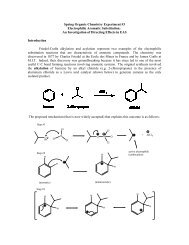Fall Organic Chemistry Experiment #6 Fractional Crystallization ...
Fall Organic Chemistry Experiment #6 Fractional Crystallization ...
Fall Organic Chemistry Experiment #6 Fractional Crystallization ...
Create successful ePaper yourself
Turn your PDF publications into a flip-book with our unique Google optimized e-Paper software.
species of organism while leaving any other inhabitants in the vicinity (including humans)<br />
unaffected. There is a great deal of examples in the chemical literature on this topic.<br />
How can we produce these enantiomerically pure compounds? There are actually a<br />
variety of techniques that range from producing mixtures of isomers and separating them to<br />
actually synthesizing the specific "pure" isomer. Some of the more common techniques are listed<br />
below:<br />
1. Asymmetric synthesis --- using chiral reagents, catalysts, and fragments to produce<br />
molecules of a SINGLE enantiomeric configuration. Results in the total synthesis of an<br />
optically active compound. The preferred technique, but is difficult when dealing with<br />
biological molecules. Biomolecules tend to be extensive and contain multiple<br />
stereocenters.<br />
2. Chromatographic resolution of enantiomers --- requires an optically active (chiral)<br />
stationary phase that allows passage of one enantiomer while the other is held up on the<br />
column. Generally applicable when dealing with a small amount of material.<br />
3. Enantiomeric enrichment --- use a pool of small, optically active (chiral) starting<br />
materials to enrich the product percentage of a desired isomer. Usually results in the<br />
partial synthesis of an optically active compound.<br />
4. Enzymatic resolution --- use of an enzyme to separate isomers.<br />
5. Enzymatic/microbial transformation --- use of an entire biological system to synthesize<br />
the product of interest from a "fed" starting material.<br />
6. Diastereomeric derivatization --- attachment of an enantiomerically pure extension<br />
(fragment) to both enantiomers to produce a diastereomeric pair. The pair can be<br />
physically separated usually by chromatography.<br />
7. Resolution of diastereomeric salts --- diastereomer formation followed by product<br />
enrichment by the selective crystallization of one diastereomer over the other.<br />
Each of these methods is commonly employed by scientists in industry, the government,<br />
and academia. In today's experiment, we are specifically interested in separating the enantiomers<br />
of racemic α-methybenzylamine by conversion to a pair of diastereomeric salts using L-(+)-<br />
tartaric acid (the resolution of diastereomeric salts). Recall, that enantiomers have identical<br />
physical properties that render them inseparable. Diastereomers, on the other hand, are separable<br />
because they have different physical properties. In this case, one of the diasteromeric salts, the<br />
(-)-amine-(+)-tartrate salt, has a lower solubility than its diastereomeric counterpart. We will<br />
fractionally crystallize the (-)-amine-(+)-tartrate salt from methanol. Once separated, we will<br />
treat the purified diastereomeric salt with base. This process will break apart the salt and<br />
regenerate the free unprotonated (-)-amine. In order to determine the enhanced purity of this<br />
enantiomer, we will again (for a second time) form a diastereomeric salt pair, this time using (S)-<br />
(+)-O-acetylmandelic acid (instead of tartaric acid) which we can analyze by NMR spectroscopy.<br />
We will do this in <strong>Experiment</strong> #7.

















